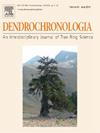测量更多——环孔早期血管年表鲁棒信号的关键
IF 2.7
3区 农林科学
Q1 FORESTRY
引用次数: 0
摘要
定量木材解剖由于其高环内分辨率和与生态生理过程密切相关,在树木年代学中应用越来越广泛。然而,环孔物种的早期血管年表往往表现出较低的统计质量,如共同信号强度弱和低表达群体信号(EPS)。这就提出了一个问题,即这些限制是木材类型固有的,还是方法的改进可以提高年表稳健性。本研究评估了每年轮测量木材的数量(切向宽度)和树木复制如何影响气候-生长关系的统计质量和可靠性。因此,我们使用高度复制的数据集(每个站点21棵树,每棵树45 mm切向宽度)进行了系统分析,并将其作为鲁棒基准。我们采用了先进的图像分析、重采样和数据模拟技术。我们的分析表明,获得的气候相关值的传播(不确定性)随着复制和共同信号强度的降低而增加,复制是影响最大的因素,其次是与切线宽度相关的树内精度。我们建议在没有强限制因素(低公共信号强度)的环境中,每棵树至少采集两个5mm核(8-10 mm TW),采样至少20棵树。与通常的做法相反,我们提倡基于表面质量而不是与树轮宽度主年表高度相关的子采样,并将EPS≥ 0.85作为早期坞血管年表的目标。最后,仔细筛选早期血管变量数组(第一行,平均大小,不同分位数等)可以最大限度地提高信号强度。我们相信,我们的方法、结果和建议可以有助于提高环孔树种定量木材解剖年表的稳健性,但也可能适用于其他木材类型。本文章由计算机程序翻译,如有差异,请以英文原文为准。
Measuring more – The key to a robust signal in ring-porous earlywood vessel chronologies
Quantitative wood anatomy is a crucial field increasingly used in dendrochronology due to its high intra-ring resolution and close link to ecophysiological processes. However, earlywood vessel chronologies in ring-porous species often show low statistical quality, such as weak common signal strength and low expressed population signal (EPS). This raises questions about whether these limitations are inherent to the wood type or if methodological refinements could improve chronology robustness. This study evaluates how the amount of measured wood per ring (tangential width) and tree replication impacts the statistical quality and reliability of climate-growth relationships. Therefore, we conducted a systematic analysis using a highly replicated dataset (21 trees per site, 45 mm tangential width per tree) from Fraxinus excelsior and Quercus robur as a robust benchmark. We employed advanced image analysis, resampling, and data simulation techniques. Our analyses show that the spread (uncertainty) of obtained climate correlation values increases with lower replication and common signal strength, with replication as the most influential factor, followed by within-tree accuracy linked to the tangential width. We recommend collecting at least two 5-mm cores (8–10 mm TW) per tree and sampling a minimum of 20 trees in environments without a strong limiting factor (low common signal strength). In contrast to common practice, we promote subsampling based on surface quality rather than high correlation with the tree-ring width master chronology and target an EPS ≥ 0.85 for earlywood vessel chronologies. Finally, careful screening within the array of earlywood vessel variables (first row, mean size, different quantiles, etc.) enables to maximize the signal strength. We believe that our approach, results, and recommendations can contribute to improving the robustness of quantitative wood anatomy chronologies in ring-porous species, but likely also in other wood types.
求助全文
通过发布文献求助,成功后即可免费获取论文全文。
去求助
来源期刊

Dendrochronologia
FORESTRY-GEOGRAPHY, PHYSICAL
CiteScore
5.50
自引率
13.30%
发文量
82
审稿时长
22.8 weeks
期刊介绍:
Dendrochronologia is a peer-reviewed international scholarly journal that presents high-quality research related to growth rings of woody plants, i.e., trees and shrubs, and the application of tree-ring studies.
The areas covered by the journal include, but are not limited to:
Archaeology
Botany
Climatology
Ecology
Forestry
Geology
Hydrology
Original research articles, reviews, communications, technical notes and personal notes are considered for publication.
 求助内容:
求助内容: 应助结果提醒方式:
应助结果提醒方式:


